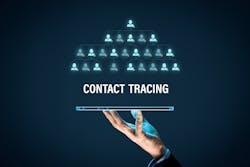In Southern California, Methodist Hospital Turns to Automated Contact Tracing Inside its Four Walls
Contact tracing has of course been touted by public health leaders as a core element of any strategy to mitigate the spread of COVID-19, but much of the attention in this area has been placed on tracing positive individuals and their close contacts in the community. At the same time, the pandemic has heightened healthcare consumers' concerns about receiving care inside the four walls of a hospital system as well.
For example, the findings of a survey released last month, conducted by SwipeSense, a Chicago-based healthcare technology company that develops a patient safety platform, revealed that 73 percent of consumers feel concerned or extremely concerned about hospital safety, which represents a 46 percent increase in their level of concern since the onset of COVID-19. The survey also found that healthcare consumers overwhelmingly feel that the use of technology to support patient safety initiatives would increase how safe they feel receiving care, with 83 percent reporting they would feel safer with contact tracing technology in place.
In California, a law that went into effect Jan. 1. established new requirements for employers to notify employees and their unions about a potential COVID-19 exposure in the workplace. But for the Southern California-based Methodist Hospital, it was never about complying with the law. The organization’s leaders knew that automated contact tracing, as opposed to antiquated, manual methods, could help the 348-bed hospital capture all close contacts of a positive individual in near real time, and also empower faster, more accurate infection control.
For a while at the onset of the crisis, however, Methodist was like many other patient care organizations that were relying on manual processes for contact tracing. So, if there was an unsafe exposure to a patient, that hospital employee had to be isolated, tested, and kept out of the building for long periods of time while waiting for the infection information to come in—even if the exposure was minimal, says Bala Chandrasekhar, M.D., the chief medical officer at Methodist. “This was also during the time when we needed a lot of healthcare workers to be working and taking care of the extra load, especially during that first surge, which occurred in May and June. But we were sending [staff] home because we didn't [have] complete contact tracing information in real time,” he adds. What’s more, in the case of asymptomatic carriers, it only made it much more difficult to trace steps back without technology, as the only other option was relying on the memory of staff members.
The organization was then contacted to leverage the SwipeSense solution, whose CEO Mert Iseri says is essentially a “a safety platform for the hospital.” The system works by providing healthcare workers with a smart badge to wear next to their employee ID badge, equipped with tracking technology. On the back end, a real-time locating system (RTLS) sensor network basically creates a “virtual map” that tracks individuals’ movements.
Via the system, when there’s an identified positive test, the automated technology tracks which rooms that person was in, and who else was in that room, within minutes, allowing hospital leaders to act quickly since every single employee is required to wear the badge. The information is accurate and complete—unlike the fragmented manual data—so if a contact is deemed as “casual” to the infected individual, rather than “close,” there wouldn’t be a need to leave the hospital and quarantine. Importantly, notes Chandrasekhar, while the system is always running in the background and collecting data continuously, the contact tracing-specific functionality only gets turned on when there has been an unsafe exposure.
Mitigating COVID-19 spread—and ensuring a safe future
What has the impact been so far? Chandrasekhar reports that since November, Methodist has used the automated contact tracing for 41 positive patients, but more importantly, 114 healthcare workers. “That is a big deal because these healthcare workers could be asymptomatic, so they could be transmitting the virus to other patients, or to their peers, or their colleagues, and also taking it home. So we wanted to quickly isolate those who have had an unsafe exposure if the contact was a ‘meaningful’ contact, as defined by the CDC. It’s been a huge savings as far as time is concerned, and also in the effectiveness and completeness of contact tracing,” he says.
To this end, the latest CDC data reports that there have been more than 400,000 cases of COVID-19 among healthcare workers. As such, SwipeSense’s Iseri says that the interest from hospitals in deploying the automated tracing technology has been “remarkable,” noting that in just 90 days, more than 20 hospitals and health systems were signed up. He compares it to the company’s hand hygiene compliance technology that took four years from building a prototype to having even 10 hospitals and health systems using it. “Typically, these kinds of decisions take a very long time, but hospitals are realizing that the need for [contact tracing] technology is immediate. The expectations of what needs to happen with pen and paper are not matching the reality of what's possible in terms of staff and the team members at hospitals on the ground right now,” Iseri contends.
One of the keys to success for effective contact tracing is participant uptake, and Clifford Daniels, chief strategy officer at Methodist, acknowledges that there was some staff apprehension in the beginning. “It was necessary to assuage those fears, and I think that we successfully did so. From an enterprise viewpoint, the reason why we implemented the contact tracing module was that we needed to have the ability to assure the community, our staff, and our patients and their families that it was safe to come to the hospital and that you weren't going to leave here sicker than when you got here. The SwipeSense contact tracing module enabled us to create the ability to track, contain and mitigate the spread of coronavirus in the hospital,” he says.
There’s also the financial hook, too; if patients still express fear of physically going in to seek care, hospitals’ business operations will continue to suffer. Daniels notes that because of the real-time data Methodist now has, there are fewer employees that are currently out due to COVID, but that number is still much higher than the hospital would ideally prefer. From a nursing standpoint alone, he says that Methodist is still paying upwards of $200 an hour for qualified and available nurses because so many in the organization remain out on COVID-related leave, whether they have the disease themselves, they have kids at home, or they have family members they need to take care of.
At the onset of the pandemic last spring, and shortly after the first big surge in Southern California, Daniels reports that Methodist saw a 50 percent decrease in ER utilization. Importantly, he adds, “It wasn't just people that were [avoiding] showing up here for sprained ankles, sore throats and earaches; we saw falloffs in heart attacks and strokes. People were literally deathly ill and avoiding hospitalizations because they thought it was safer to incur the aftereffects of a stroke or a heart attack at home, rather than to come to the hospital and potentially catch COVID-19.”
Daniels notes that fortunately, there are now signs of recovery, and patients are noticing that it’s safe to come back. “For us, it was all-hands-on-deck to make sure we mitigated that spread here in the hospital, and the SwipeSense technology has really helped us do that.”


